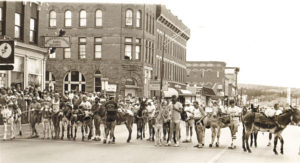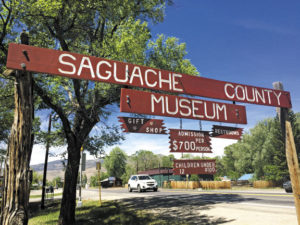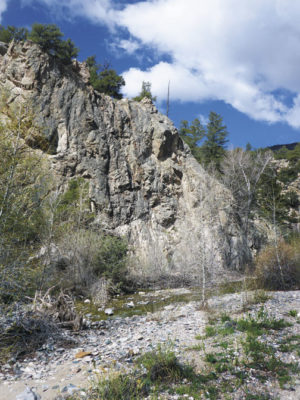A couple months ago, I marched for science in Gunnison with a handful of the several hundred thousand Americans marching throughout the nation, and a week later, in cold blustery weather, marched for the climate up in Crested Butte. These were enjoyable events with others like myself who currently feel ignored by a political administration that has no apparent respect for science, among other things.
But I did find myself wondering what the marches really had to do with science. Marching for anything is a political act, and I don’t think of science as a political activity. But the history of civilization, especially in times of city-building, has always shown an uneasy relationship between science and politics – like a dance whose partners can’t quite decide who should lead.
The main distinction between science and politics is the dedication of scientists to their scientific method: a disciplined process of testing possible answers – hypotheses – to questions roused by observations of problems. Even when a scientist demonstrates the validity of a hypothesis, it does not end there; the scientist’s analytical process has to be reviewed by other scientists; only if peers accept the scientific rigor of the work does it become another leaf on the great branching tree of science.
Politics is also a process of trying to develop workable hypotheses for addressing society’s problems, but while some politicians do show similar discipline in accumulating evidence in support of policy ideas, they have no discipline requiring it, or for testing their ideas.
Politicians also permit – and vigorously practice – something that scientific methodology absolutely rejects: using received or revealed knowledge, of the genre, “this I know because the Bible tells me so” (or the Constitution or the Koran or other cultural icons).
Politics also has no review process whereby political ideas can be removed from public discourse for not adhering to a methodological process, because there is no inviolable process – as Congress shows today. Thus “zombie ideas” unsubstantiated by any evidence of validity can forever haunt our politics. They can even persist in the face of evidence that contradicts them. For example, tax cuts for the wealthy that will trickle down as new jobs. Instead of discipline and evidence, we let politicians use charisma and emotional appeals to sway us.
But, fundamental differences notwithstanding, that uneasy relationship between science and politics has given us what is surely the most incredible century of change in human history. Since 1900 the human population has quadrupled; our life expectancy has doubled; and most of us in the First World, live lives of comfort and freedom once enjoyed only by royalty. This would not have happened without a lot of mutual interaction between political forces, scientists, and the engineers and technocrats who implement the changes.
So why have we now, the beneficiaries of all this, decided – however narrow the vote – to let the politicians end their dance with science? All this was rattling around in my mind, not just at the marches, but more recently during a rambling and irresponsible carbon-spewing automobile tour of the Northwest.
The trip included a pilgrimage to Grand Coulee Dam in eastern Washington. Ostensibly, my deep immersion in current Colorado water issues was reason enough for wanting to visit that great American water project – although that might make my anti-dam colleagues here nervous. But for my partner and me, the real reason was a visit to another America, the America of the 1930s. An America still in the slough of depression, psychological as well as economic, but beginning to struggle out with projects like the great dam rising in that Washington coulee.
Large as the dam itself is, the story told in the Park Service’s excellent exhibit hall is larger. Like Hoover Dam before it, the Grand Coulee project created thousands of regional jobs directly and indirectly, cheap and renewable electric power for farmers and major industries alike, including aluminum production, which in turn, lowered costs for other growing industries such as aircraft production. It provided water and the power to move it uphill to the plateaus above the coulees, for what was originally to be thousands of small irrigated farms intended for a massive relocation of Dust Bowl farmers, so their old homesteads could revert to prairie.
But the most important thing the Hoover, Grand Coulee and Tennessee Valley projects really provided, for the whole nation, watching newsreels of these huge piles of concrete and steel rise out of their canyons, was an almost tangible hope, a positive sense that things were indeed turning around. Historian Charles Beard, in a 1931 Harper’s essay, spoke of the New Deal as the dawn of a new era of “technology, science, and rationalized economies,” with enlightened neocapitalists and public capital joined to benefit all the people.
No one probably said it better than the farmer who stood up in church after the REA reached his family home, and proclaimed, “Brothers and sisters, the greatest thing on earth is to have the love of God in your heart, and the next greatest thing is to have electricity in your house.” Woody Guthrie trekked to Grand Coulee to write songs in praise of the great Columbia dams that were turning our night into dawn.
One of the most enduring thing to come out of the Grand Coulee Project might be Kaiser Permanente, the health maintenance organization which was hatched in a hospital the enlightened industrialist Henry Kaiser built there for the workers – an almost unprecedented idea in American capitalism: taking care of the workers! But the politicians were also listening to the social scientists, and wanted enlightened capitalists to improve human lives as well as make money building the economy.
[InContentAdTwo] The role of science and technology in this Planned Promised Land was foundational, from the large-scale irrigation to the power to the social welfare ideas; that creative impetus for science continued right on into and through the ensuing war effort. President Roosevelt himself sounded more like a scientist than a politician in exhorting the nation to “Try something. If it doesn’t work, try something else!”
But was it really science? Where was the discipline, the process of testing and vetting ideas before applying them? The huge regional projects themselves had become the testing process; the experiments were using real people and their lives. Between the New Deal and the war effort, the politicians had essentially captured the scientists and engineers – were leading the dance, as it were.
And on that scale, of course not everything worked, certainly not according to the original hypotheses. The West, for example, was already so deeply into urbanization and industrialization that large-scale agribusiness rather than Jefferson’s small farmers co-opted the projects’ irrigated land. The dams, the expanding farmland, new agribusiness practices, the electric grid, and the vast industrial expansion it all leveraged, created environmental problems not even imagined in 1930. By the 1960s, it was evident that this was taking a serious toll on the planet’s natural systems. The political technocracy – organizations like the Bureau of Reclamation – soldiered on, trying to deal with new problems while keeping the original vision alive, but they were up against the old engineer’s dilemma: When you’re up to your ass in alligators, it’s hard to keep draining the swamp.
A new school of environmental scientists emerged, doing disciplined science to engage the new concerns, with a passion inversely proportional to their public funding. But much of the general public, already taking the New Deal’s electricity and roads and bridges and waterworks and other accomplishments for granted, came to agree in the 1960s that enough development was enough, and elected new legislators that pushed through a body of environmental law that seriously slowed, for true scientific analysis, the exploitation, degradation and extinction of planetary resources. Essentially, politics in the late ‘60s and ‘70s was captured by the new scientists and their public support – a reversing of the situation in the 1930s when the scientists and engineers were swept up into the political vision.
What can we make of this century of interaction, this shifting relationship between science and politics? When the politicians led the dance, the dance was fast and sloppy and produced a lot of alligators. But, it also used science to produce an atmosphere of hope and positive energy that generated an unprecedented period of general prosperity. Well, that might have thoroughly destroyed the planetary environment, had the scientists not stepped back in to restore real science and taken the lead in the dance.
But if the scientists have now demonstrated that the New Deal hope was a naïve hope – they have not proved successful in replacing that hope with a hope that resonates with the people. Last year, all the counties in the coulee country benefitting from the great dam went heavily for Trump, joining most of the rest of the rural counties in America – all with their REA electricity, New Deal paved roads, and bridges and waterworks – in voting for the man who offered them an even more naïve and nostalgic hope, divorced from science.
Obviously, I am still not entirely sure what I was marching for, or against, last month. A better balance of science and politics? One can only hope.
George Sibley lives, works and writes in Central Colorado’s Upper Gunnison Basin.




